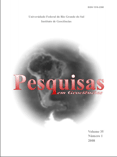Aspectos da Otimização e Processamento de Redes GPS
DOI:
https://doi.org/10.22456/1807-9806.19592Palavras-chave:
GPS network processing GPS, optimization, geodetic network densification.Resumo
This paper deals with some aspects which should be taken into account for the densification of geodetic network using GPS technology, specially in the concern of Earth body tide modes, ambiguity resolution and the variance propagation of the network constrains. Based on trials accomplished for a GPS network, some aspects of GPS network optimization and processing are presented. In network optimization, applied to GPS networks, are presented the Zero Order, First Order and Second Order Problems, showing the needs of planning the GPS observations and processing in such a way that one can reach the required accuracy with high reliability and low costs. In the tests to evaluate the need for applying Earth body tide model, it was verified that it is necessary for baselines longer than 200 km for the majority of network application. It was noticed that the ambiguity solution should always be analyzed before accepting a fixed solution as the best, since the presented results demonstrated that some fixed ambiguities are inconsistent. In the processing trials with fixed constrains (without taken into account the precision) or fiducial constrains (with associated precision), it was noticed that the former provided better dispersion values for the new points, however, the last one provided more reliable values, since the new points have associated with themselves the uncertainty of the datum points.



